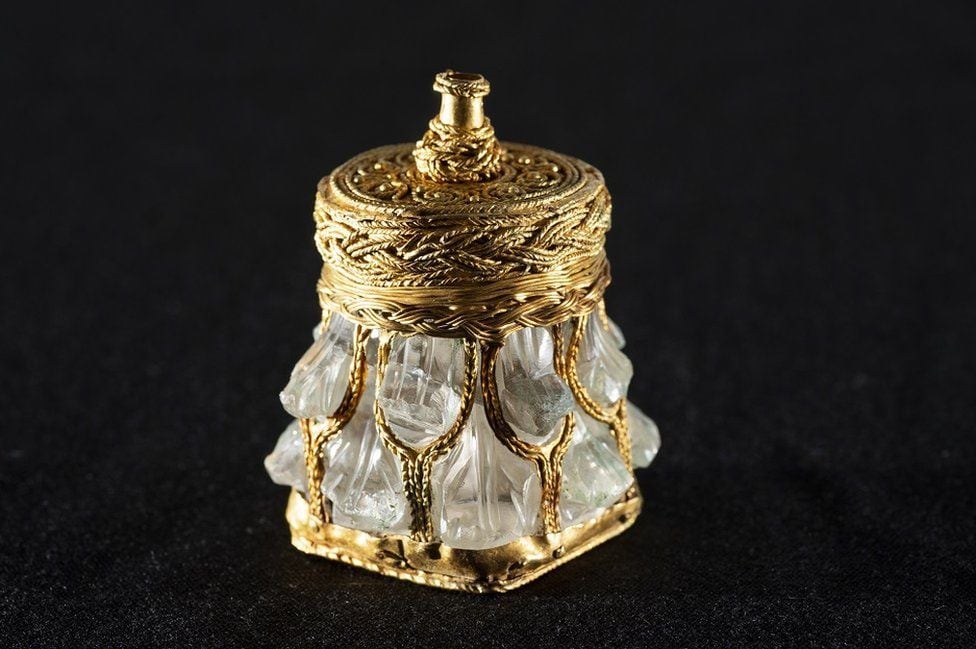Neuvěřitelná krása. Ať už hledáte mince, válku.. tohle je jako ze sna .)
An 8th-century cruciform vessel hid the name of an unknown Anglo-Saxon bishop
Categories: Nálezy nejenom s detektorem ve Velké Británii a Irsku
The unique crystal vessel decorated with gold comes from the so-called. "Galloway hoard", the largest Viking and Anglo-Saxon detector find in Britain and Ireland, discovered by Derek McLennan in 2014. Now it has surprised experts at National Museums Scotland (NMS) who, while cleaning its base, have uncovered an inscription bearing the name of a bishop from the early medieval Anglo-Saxon kingdom of Northumbria.
The Galloway Treasure is an extremely rare collection of objects, second to none. It was discovered by retired soldier and entrepreneur Derek McLennn using a metal detector in southern Scotland eight years ago. The collection of Viking and Anglo-Saxon objects has been continuously analysed ever since. It was purchased by the National Museum of Scotland for £1,980,000 (about 58 and a half million pounds) in 2014; the finder got half. Comprehensive research, conservation and cleaning followed, revealing a staggering amount of of rare objects in a fabric-wrapped silver and gilt Carolingian-style pot.
Prior to the actual cleaning, conservators had the pot and its contents CT scanned, revealing unique objects carefully wrapped in textiles. One of the amazing artifacts was a crystal vessel just recently unveiled, decorated with gold wires and layers of gold thread. It dates from the late 8th or early 9th century. At the bottom of the vessel, researchers discovered a gilded Latin inscription, the translation of which reads, "Bishop Hyguald had me made." Experts said it was "annoyingly difficult" to identify the person, but it seems he may have been a bishop from the mid-9th century.
3D X-ray imaging was needed to reveal the inscription, which was carried out in collaboration with the British Museum. Experts say it is the "clearest evidence" that some of the objects in the hoard could have come from the Anglo-Saxon kingdom of Northumbria, which then included present-day Dumfries and Galloway.
"Sources and records from this period are incomplete, but we do know from them that there were several clerics called Hyguald in early medieval Northumbria, explained Professor Alex Woolf, associate professor at the University of St Andrews. "We don't know specifically about Bishop Hyguald, but our lists of Northumbrian bishops after 810 are incomplete. So it's frustrating - it's hard to be more precise, but we can assume we're looking at the subject of a previously unknown mid-9th century bishop of Whithorn or Hexham."
NMS Chief Curator Dr. Martin Goldberg said there were parallels in the Roman Empire for objects of this type: "The ones I have seen are in the Vatican collection, where there are various forms of carved crystal columns," he said. "And so maybe some of them were 500 years old when they were transformed into a gold-encased jar in the late 8th or early 9th century."
Dr. Leslie Elizabeth Webster, professor of history and lifelong curator of prehistoric and early medieval Europe at the British Museum, believes the jar came from a high-profile workshop: "This object is absolutely fascinating. I've seen a lot of Anglo-Saxon finds over the many years of my professional career, some of them amazing. But this absolutely blows them all out of the water."
Most of the Depot's artefacts are currently on display at Kirkcudbright. Some of the material with fragile textiles is still undergoing careful conservation and the development ofresearch, which, even after eight years since its discovery, has not ended and is sure to yield surprising new findings and results...
Link to a 3D scan of the vessel
Roman Nemec
Sources: thehistoryblog.com, bbc.com




The article is included in categories:








 :,-
:,- 






